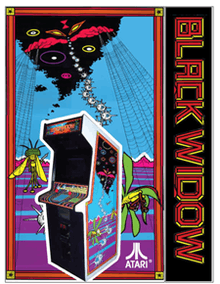Black Widow (video game)
Black Widow is a vector arcade game developed by Atari, Inc. released in 1982. The player takes the role of a black widow spider defending a web from invading bugs. The player must move the spider around the web while simultaneously shooting/avoiding various bugs and collecting the bonuses that appear after the enemies are eliminated. The game is a twin-stick shooter in the vein of Robotron: 2084 by Williams, but with fewer enemies on-screen.
| Black Widow | |
|---|---|
 Manual cover | |
| Developer(s) | Atari, Inc. |
| Publisher(s) | Atari, Inc. |
| Designer(s) | Bruce Merritt[1] |
| Platform(s) | Arcade |
| Release | 1982 |
| Genre(s) | Multidirectional shooter |
| Mode(s) | Single-player |
| Cabinet | Horizontal |
| CPU | 1 × 6502 @ 1.512 MHz[2] |
| Sound | 2 × POKEY @ 1.512 MHz |
| Display | Vector (color) |
Black Widow was offered as a conversion kit for Gravitar, which was not a successful title. The kit used the original Gravitar PCB with a few small modifications and a new set of ROM chips. Many factory-built Black Widows were produced using unsold Gravitar cabinets with Black Widow sideart applied over the Gravitar sideart.
Gameplay

To destroy certain enemies, the player must lure other enemies into destroying them. There is also the Bug Slayer, a bug that helps the player eliminate enemies, with only loss of potential points being the only consequence. The Bug Slayer can help the player in tough situations, but can also prevent the player from achieving the number of extra lives necessary to endure later, more difficult, rounds. Also, other enemies appear on the playing field as eggs, laid by other enemies. The player can move these eggs off the playing field to both eliminate the enemy and receive points, before it reaches maturity.
Enemies and Scoring
- Mosquito - If shot, becomes '
Legacy
Black Widow was included in Atari Anniversary Edition Redux for the Sony PlayStation, released in 2001. In 2003, Microsoft Windows could play Black Widow as part of Atari - 80 Classic Games in One!. Released in 2004, Atari Anthology ported the game to the PlayStation 2 and Xbox gaming consoles, and in 2005, the Nokia N-Gage cellular phone received a copy of Black Widow in Atari Masterpieces Volume 1.
James Vollandt holds the official record for this game with a maximum 930,100 points.[3]
References
- Hague, James. "The Giant List of Classic Game Programmers".
- "Black Widow". Arcade History.
- Twin Galaxies. "Black Window Scores". Archived from the original on October 23, 2007. Retrieved July 19, 2010.
External links
- Black Widow at the Killer List of Videogames
- Black Widow at the Arcade History database
- Rare Game Room Gems: Black Widow by Atari at The GameRoom Blog
- Caught in the Web: An Appreciation of Ataris Black Widow at the Retroist